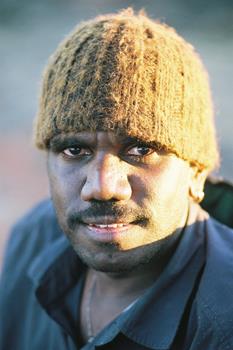KIRRIWIRRI, 2007
DANIEL WALBIDI
synthetic polymer paint on linen
70.0 x 232.0 cm
bears inscription verso: artist’s name, date, medium, size and Short Street Gallery cat. 2651F
Short Street Gallery, Broome
Dr Ann Lewis AO, Sydney
Mossgreen Auctions, Sydney, 7 November 2011, lot 39
Private collection, Sydney
This work is accompanied by a certificate of authenticity from Short Street Gallery.
2009 Western Australian Indigenous Art Awards, Art Gallery of Western Australia, Perth, 25 July - 15 November 2009 (label attached verso)
220076.jpg

Kirriwirri, 2007 was originally commissioned for the small cruise ship, ‘The Orion’, by the ship’s owners. Intended to be hung on an end wall of the vessel’s dining room, the work was painted to the size and specifications of the planned location. When the commission did not proceed, the painting was acquired by Dr. Ann Lewis who had viewed the painting in Perth at The Western Australian Art Award exhibition in 2009.
The work is accompanied by a certificate from Short Street Gallery with a statement from Daniel Walbidi which states in part: ‘ “Kirriwirri” is my grandfather’s and my grandmother’s country. That is where they brought up all their kids, and where my father was brought up. It is like their family home, their roots. There is a big claypan at this place, it is an important place for our family. Our clan is also named Kirriwirri, and individual members of our clan are named Kirriwirri.’
‘Painting is not just what you see.’1
Having spent his entire life living in the coastal town of Bidyadanga in north-west Western Australia, Daniel Walbidi’s Kirriwirri, 2007 is a personal exploration of the artist’s heritage from afar. The painting documents a place he had never visited before 2007 yet had imagined, having grown up listening to the Dreaming stories from this unknown and foreign place. Kirriwirri, located in the Great Sandy Desert close to Well 33 on the Canning Stock Route, was the traditional country of Walbidi's parents, grandparents and home to other clan and family groups. During the 1960s after a severe and widespread drought dramatically affected their desert country, drying up lakes and rock pools completely, they were forced to migrate from their homeland to Bidyadanga or La Grange Mission, a coastal community south of Broome.
This desire to paint the traditional country of his family, particularly the important Jila (living water) sites at Kirriwirri and Wirnpa, was the impetus for the emergence of an unexpected art movement of the Yulparija people based at Bidyadanga. In 1999, when just sixteen and acutely aware of the cultural displacement of his people, Walbidi visited Short Street Gallery in Broome to exhibit some of his paintings, with the wider hope that an artistic community could be established. This event led to the Gallery providing a group of elders with modern painting materials which were embraced enthusiastically by Yulparija painters such as Weaver Jack, Alma Webou and Parlurn Harry Bullen, who took the opportunity to depict their history reviving the tradition and heritage of the Yulparija, resulting in the Bidyadanga art movement.2
In late 2007, Walbidi finally travelled to his traditional lands around Winpa and Kirriwirri on a trip with senior artists, including his father. The visit was intended to rejuvenate the ancestral connections between the Yulparitja and their country, and deeply inspired Walbidi, marking a transition in his career. Having also seen for the first time, his country from the air, his later works, evident in paintings like Kirriwirri, are characterised by tighter composition with blocks of bright patchwork colours mapping out all the Jila and revealing details of his country. As the accompanying certificate explains ‘Daniel’s painting reflects the complex desert landscape full of life and colour. He depicts salt lakes (white areas) and the talis (sand hills).’3
1. Walbidi, cited in 'Daniel Walbidi,' in Lane, C., and Cubillo, F., (eds.), unDisclosed: 2nd National Indigenous Art Triennial, National Gallery of Australia, Canberra, 2012, p. 124
2. Rohr, E., 'Bidyadanga', in Beyond Sacred: Australian Aboriginal Art, The Collection of Colin and Elizabeth Laverty, Kleimeyer Industries, Melbourne, 2011, p. 160
3. See the accompanying Short Street Gallery certificate
CRISPIN GUTTERIDGE
